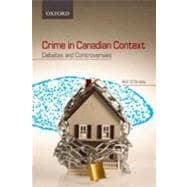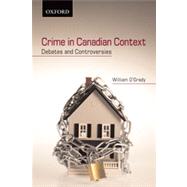Crime in Canadian Context

Crime in Canadian Context
- ISBN 13:
9780195422955
- ISBN 10:
0195422953
- Format: Paperback
- Copyright: 08/09/2007
- Publisher: Oxford University Press
- Newer Edition
Rent
Sorry, this item is currently unavailable.
Note: Supplemental materials are not guaranteed with Rental or Used book purchases.
Extend or Purchase Your Rental at Any Time
Need to keep your rental past your due date? At any time before your due date you can extend or purchase your rental through your account.
Summary
Crime in Canadian Context is an introductory level textbook that will provide students with a concise, yet thorough review of criminology in Canada today. The book focuses on key issues and questions recent to the discipline, while remaining sensitive to classical material that was so centralin shaping the early days of criminology.The opening chapter focuses upon how crime is defined and discusses the role that the mass media plays in representing crime to society. Tackling some of the myths and misconceptions propagated through the media serves as a valuable entree into the field of criminology and a basis for confrontingthe various myths of crime and criminal justice. Chapter 2 provides an overview of methods that are used to measure crime and conduct empirical research. The strengths and weaknesses of official police statistics, self-report studies, victimization surveys and observational studies are all reviewed in this second chapter. Chapter 3 is the first of three chapters that are devoted to criminological theory. Beginning with pre-scientific thought and early religious doctrine that considered much abnormal behaviour to be the result of generalized force of evil, the reader is then presented with early biologicalexplanations which suggested that crime was due to a wide range of physical abnormalities. The role that psychology has played in the study of criminal behaviour will also be examined. Then the author explores how the sociological approach to crime fundamentally differs from non sociologicalconceptions of criminal behaviour. Chapter 4 introduces the reader to early sociological explanations of crime. Chapter 5 continues to examine criminological theory by focusing on more recent developments in the field. The specific theories that will be introduced here will include the GeneralTheory of Crime, General Strain Theory, Rational Choice Theory, the Life Course approach, Environmental Criminology and Actuarial Criminology. Chapter 6 tackles the issue of crime and social exclusion - a concept of social inequality that originated in Europe - by examining a selected number of groups in Canadian society who are either at a high risk to offend, or are prone to criminal victimization due their exclusionary status. Issuessurrounding homeless youth, gang members, Aboriginal people, women who experience partner violence and hate crime will be explored. To reinforce the fact that not all crime takes place within groups in society that have been marginalized or excluded, Chapter 7 explores wrongdoing that occurs within organizations that are economically powerful or are privileged on the basis of their social status. Crime that occurs withincorporations, governments, police and religious organizations will be the topics examined in this chapter. In Chapter 8 the reader is introduced to the law and order approach to crime as well as the structure and organization of the Canadian Criminal Justice System. The reader is introduced to harm reduction and restorative justice. Chapter 9 provides a brief summary of the main issues raised throughout the book, and offers commentary about the role that criminology plays in the field of criminal justice policy.







